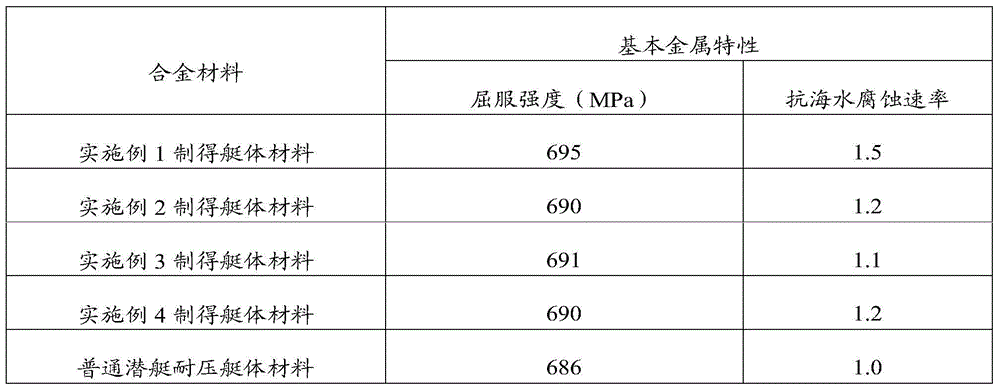Pressure withstanding submarine body material for submarine and preparing method thereof
A pressure-resistant and hull technology, applied in the field of submarine pressure-resistant hull materials and its preparation, can solve the problems of lack of economic and technical strength in titanium reserves, and achieve the effect of high hardness and excellent compression resistance
- Summary
- Abstract
- Description
- Claims
- Application Information
AI Technical Summary
Problems solved by technology
Method used
Image
Examples
Embodiment 1
[0032] Step a, preparing the raw materials of the submarine pressure-resistant hull material, the ratio of each raw material element by mass percentage is: carbon nanotube 2%, manganese 0.35%, chromium 2.0%, nickel 0.6%, molybdenum 0.9%, tungsten 2%, ytterbium 0.20%, rhenium 0.20%, and the rest is iron.
[0033] Step b. Add iron, manganese, chromium, nickel, molybdenum, tungsten, ytterbium, and rhenium as raw materials to be smelted into the vacuum chamber of the platinum crucible, and vacuumize to make the vacuum degree reach -0.1MPa. Melt in vacuo for 1 hour.
[0034] Step c, refilling with argon gas to make the pressure reach 100 MPa, adding carbon nanotubes, and keeping the temperature for 40 minutes to melt evenly.
[0035] Step d, keeping the pressure down to room temperature at a cooling rate of 100° C. / min to obtain a finished submarine pressure-resistant hull material.
Embodiment 2
[0037] Step a, prepare the raw materials of the submarine pressure-resistant hull material, the ratio of each raw material element by mass percentage is: carbon nanotube 5%, manganese 0.65%, chromium 2.75%, nickel 1.0%, molybdenum 1.2%, tungsten 4%, ytterbium 0.30%, rhenium 0.30%, cerium 0.30%, and the rest is iron.
[0038] Step b. Add iron, manganese, chromium, nickel, molybdenum, tungsten, ytterbium, rhenium, and cerium as raw materials to be smelted into the vacuum chamber of the platinum crucible, and vacuumize to make the vacuum degree reach -0.1MPa. Melting under vacuum conditions for 2 hours.
[0039]Step c, refilling with argon gas to make the pressure reach 120 MPa, adding carbon nanotubes, and keeping the temperature for 50 minutes to melt evenly.
[0040] Step d, keeping the pressure down to room temperature at a cooling rate of 110° C. / min to obtain a finished submarine pressure-resistant hull material.
Embodiment 3
[0042] Step a, prepare the raw materials of the submarine pressure-resistant hull material, the ratio of each raw material is: carbon nanotube 3.5%, manganese 0.5%, chromium 2.35%, nickel 0.8%, molybdenum 1.1%, tungsten 3%, ytterbium 0.25%, rhenium 0.25%, cerium 0.25%, and the rest is iron.
[0043] Step b. Put the raw materials iron, manganese, chromium, nickel, molybdenum, tungsten, ytterbium, rhenium and cerium to be smelted into the vacuum chamber of the platinum crucible, and vacuumize to make the vacuum degree reach -0.1MPa. Melting under vacuum conditions for 1.5 hours.
[0044] Step c, refilling with argon gas to make the pressure reach 110 MPa, adding carbon nanotubes, and keeping the temperature for 45 minutes to melt evenly.
[0045] Step d, keeping the pressure down to room temperature at a cooling rate of 105° C. / min to obtain a finished submarine pressure-resistant hull material.
PUM
 Login to View More
Login to View More Abstract
Description
Claims
Application Information
 Login to View More
Login to View More - R&D
- Intellectual Property
- Life Sciences
- Materials
- Tech Scout
- Unparalleled Data Quality
- Higher Quality Content
- 60% Fewer Hallucinations
Browse by: Latest US Patents, China's latest patents, Technical Efficacy Thesaurus, Application Domain, Technology Topic, Popular Technical Reports.
© 2025 PatSnap. All rights reserved.Legal|Privacy policy|Modern Slavery Act Transparency Statement|Sitemap|About US| Contact US: help@patsnap.com

